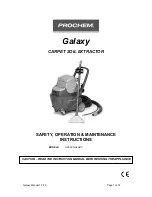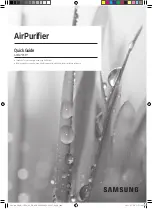
CONAIR 8-IN-1 GARMENT STEAMER
IMPORTANT SAFETY INSTRUCTIONS
When using electrical appliances, especially when children are present,
basic safety precautions should always be taken, including the
following:
READ ALL INSTRUCTIONS BEFORE
USING
DANGER
- Any appliance is electrically live even when the
switch is off. To reduce the risk of death by electric shock:
1. Always “unplug it ” immediately after use.
2. Do not place or store appliance where it can fall
or be pulled into a tub or sink.
3. Do not place in, or drop into water or other liquid.
4. If an appliance falls into water, “unplug it” immediately. Do
not reach into the water
.
WARNING
- To reduce the risk of burns, electrocution, fire, or
injury to persons:
1. Do not overfill steamer since it can cause hot water to boil out
and burn.
2. Close supervision is necessary when this appliance is used
near children or by the physically challenged. Unsupervised
use could result in fire or personal injury. This appliance is not
intended for use by persons ( including children ) with reduced
physical, sensory or mental capabilities, or lack of experience
and knowledge, unless they have been given supervision
or instruction concerning use of the appliance by a person
responsible for their safety.Children should be supervised to
ensure that they do not play with the appliance.
3. Use this appliance only for its intended use as described in
this manual. Do not use attachments not recommended by the
manufacturer.
4. Never operate this appliance if it has a damaged cord or plug, if
it is not working properly, or if it has been dropped or damaged,
or dropped into water. Do not attempt to repair the appliance.
Incorrect reassembly or repair could cause a risk of fire, electric
shock, or injury to persons when the appliance is used. Return
the appliance to Conair Service Centre for examination and
repair.
5.
Keep the cord away from heated surfaces. Do not allow cord
to contact heated surfaces. Do not pull or twist cord. Let
appliance cool completely before putting away. Loop cord
loosely around appliance when storing.
6.
Do not use outdoors or operate where aerosol (spray) products
are being used or where oxygen is being administered.
7.
Do not use an extension cord to operate appliance.
8.
Surfaces of this appliance may be hot when in use. Do not let
eyes or bare skin touch heated surfaces.
9.
Do not operate steamer without proper filling the water
container.
10.
Always keep the hose and nozzle elevated above the water
container.
11.
Never pour water directly into reservoir. Put water only in water
tank.
12.
To reduce likehood of circuit overload, do not operate another
high wattage appliance on the same circuit.
13.
While it is not recommended, if an extension cord is absolutely
necessary, a 13 ampere rated cord should be used. Cords
rated for less amperage may overheat. Care should be taken
to arrange the cord so that the cord cannot be pulled or tripped
over.
14.
Use with caution when changing attachments. Please be sure
the unit is off and no steam is being released to avoid contact
with hot water.
15.
Use with caution when changing attachments as they may
contain hot water from condensation nozzle. It should never
be placed on the unit when in use or when preheating. Ensure
the attachments are dry or cooled off to avoid contact with hot
water.
16.
Allow unit to cool before emptying reservoir for storage.
17.
Only use clean cold water for filling this appliance.
18.
In hard water areas we recommend the use of distilled water.
19.
Use with caution when removing hose cap. Remove slowly.
20.
Do not use if unit has been dropped or damaged.
CAUTION
1. This appliance should never be left unattended when plugged
in.
2. Never drop or insert any object into any opening or hose.
3. Do not place the steam nozzle directly on any surface or on the
appliance power cord while it is hot or plugged in .
4. While emitting steam, this appliance may cause burns if
it is used too close to the skin, scale or eyes, or if it is used
incorrectly. To reduce the risk of contact with hot water emitting
from steam vents, test appliance before use by holding it away
from body.
5. Do not steam garments while on a person.
6. Before unit is turned on the hose must be extended, and place
it in the hook.
7. Never yank cord to disconnect from outlet, instead, grasp plug
and pull to disconnect.
8. Burns could occur from touching hot metal parts, hot water
or steam. Use care when you turn a steam appliance upside
down - there may be hot water in reservoir.
9. Use with caution when carrying steamer as it contains hot
water.
Caution:
Hose will be hot when in use. Avoid prolonged
contact.
KEEP THESE INSTRUCTIONS
FOR HOUSEHOLD USE ONLY
UNPACKING INSTRUCTIONS
Place the box on a large sturdy flat surface. Carefully remove
the appliance from the packing material. Keep all plastic bags
away from children.
STEAMER ASSEMBLY
STEP 1 – Assembling the Support Rod
1. Insert pole with bigger diameter side
into receptacle in base
(fig a)
2. Slide plastic connector onto it
and fix the connector tightly (fig b)
3. Open the locking tab and pull out the telescope pole totally
(fig c)
4. Lock up the tab (fig d)
5. Slide hook into the top of the pole (fig e)
STEP 2 –
Attaching the steamer Hose
Assembly process:
1. Align to unlock arrow 2. Press 3. Turn clockwise till align to lock
arrow
Removing the Steamer Hose (make sure unit has been
cooled)
Disassembly process:
1. Turn counterclockwise till align to unlock arrow 2. Pull
USING THE LINT REMOVING ATTACHMENT
(USED IN CONJUNCTION WITH STEAM
ATTACHMENT)
·
This attachment is perfect for removing lint from delicate
garments. It is used in conjunction with the T-nozzle.
·
To attach the lint removing attachment to the T-nozzle, first
ensure that the appliance is “ off ” and the T-nozzle is cool.
Position the lugs on the bottom of the lint removing attachment
over the corresponding grooves on the base of the T-nozzzle.
Then push the upper part of the lint removing attachment
towards the T-nozzle till the latch on the top of the attachment
clicks into place.
·
Use it in the same manner as the T-nozzle but begin at the
top of the garment and move downwards to ensure that the
attachment head touches the surface of the fabric.
·
After use, switch the appliance “ off ” and wait for the T-nozzle
to cool. Then remove the lint removing attachment from the
T-nozzle by pressing the base of the latch on top of the lint
removing attachment. Push upwards until the latch becomes
dislodged and remove from the T-nozzle. Brush away any lint
that may have gathered on the attachment head.
Position and push the
lugs on the bottom
of the lint removing
attachment towards
the T-nozzle till clicks
into place
Lint removing
attachment
USING THE SILICON BRUSH ATTACHMENT
(USED IN CONJUNCTION WITH STEAM
ATTACHMENT)
·
This attachment is ideal for ultimate pressing performance,
e.g. cotton, polyester and nylon etc.
·
Use it in the same manner as the lint removing attachment.
USING THE CREASE ATTACHMENT (USED IN
CONJUNCTION WITH STEAM ATTACHMENT)
·
This pressing attachment creates creases for trousers and
sleeves and general smoothing.
·
Use it in the same manner as the lint removing attachment.
USING THE COTTON COVER ATTACHMENT
(USED IN CONJUNCTION WITH STEAM
ATTACHMENT)
·
This attachment is idea for hard surface cleaning.
·
To attach the cotton cover to the T-nozzle.
Attachment
Fabric/
Material
Cotton
Wool
Polyester
Nylon
Hard surface
e.g.glass window
OPERATING INSTRUCTIONS
BEFORE FILLING THE WATER CONTAINER
Turn the water container upside down and inspect to make
sure the valve and spring assembly are functioning. Place the
container in the reservoir and check that it is seated securely.
If the container has been stored with water inside, it may be
Position and push the
lugs on the bottom
of the silicon brush
attachment towards
the T-nozzle till clicks
into place
Silicon brush
I n s e r t t h e c re a s e
attachment into the
tag of the T-nozzle for
creating creases
Crease
attachment
To attach the cotton
cover to the T-nozzle
Cotton cover
attachment























